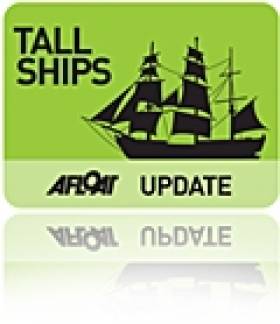Displaying items by tag: Sail
Cobh Trad Sail Maritime Lecture Series 2016
Cork Harbour's Cobh Trad Sail Maritime Lecture Series 2016 will be its most diverse, celebrating the harbour's great maritime tradition.
11th Feb: Escaping to Europe by Sea Humanitarian Operations in the Mediterranean 2015 by the Irish Naval Serice. Presented by Commander Ken Minihane and Lt Joe Daly.
18th Feb: Parking a City Berthing a Large Liner at the Deep Water Quay Cobh. Presented by Tony Mulcathy, Cork Harbour Pilot.
2nd March: Our Rankin Boats. History of Rankin Boat Building in Cobh Presented by Eddie English, Sailing Instructor
All lectures held in the Sirius Art Centre, Cobh at 20.00 hrs.
Entrance fee €5.
New 'More Durable' Laser Sail Announced By CH Marine
Irish Laser agent Nick Bendon of CH Marine has announced the new Standard Mark II Sail for the Olympic dinghy has just been signed off by the Laser class and ISAF for most competition. The sail will not be legal for ISAF World Cup competitions nor for the 2016 Olympics.
Official launch of the class approved Mark II sail is set for November 1st, 2015 and CH Marine will accept pre-orders. CH Marine is quoting prices of €569 and £385 Inc VAT and free delivery.
Following the Olympic Games in Rio, the sail will be class legal for all competition. This new class approved sail is more durable due to its bi-radial construction, it is manufactured out of longer lasting 4.5 ounce Dacron cloth with optimized sail patches, tapered battens with Velcro batten pocket closures, and the new luff tube design is easier on the upper spars.
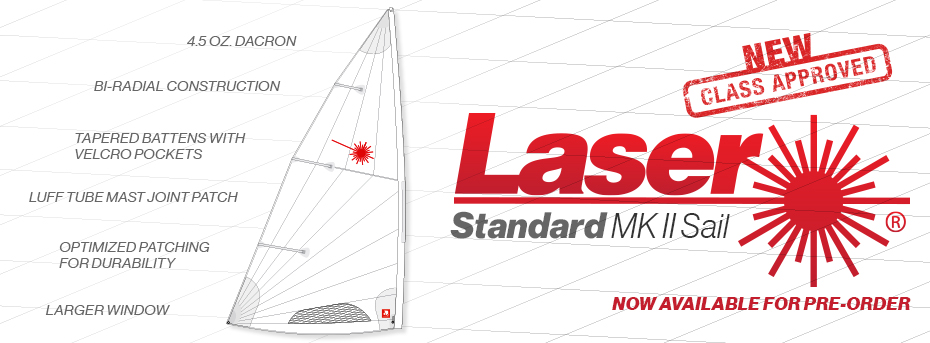
Specs:
- Bi-radial construction
- Larger window
- Tapered battens in Velcro fastened pockets
- Luff tube mast joint patch
- 4.5 oz Dacron sailcloth
- Optimized patching for durability
- Red sunburst
- ILCA Sail Button
#tallship – The visit of the Tall Ships to Belfast from July 2nd to 5th was anticipated with an enthusiasm which was fully justified by the numbers which became involved. Sixty vessels of all sizes assembled on both sides of the River Lagan in the rejuvenated docklands area and the Titanic Quarter, with a goodly sprinkling of the Class A full-rigged ships dominating the scene. And in a well-organised shoreside transport scheme involving Park & Ride centres in the suburbs, the people were able to get to the clean new quaysides in their thousands, in their tens of thousands, in their hundreds of thousands – indeed, it's reckoned that when those who clustered along the shores of Belfast Lough to watch yesterday's departing Parade of Sail are added in, well over half a million people were involved.
At the many events in Belfast Docks, organisers Sail Training International reported that the number of people making a point of personally going aboard one of the Tall Ships was unprecedented at any port since the international programme was launched way back in 1956, underlining the great interest there is in these ships, and what they do. In future discussions on Afloat.ie, we'll be looking at how the success of this event will affect the re-development of a proper sail training programme in Ireland north and south. But for now, with the Sail Training Races 2015 started this afternoon off Portrush on the north coast after the fleet had sailed there from yesterday's departure from Belfast Lough, W M Nixon recalls some memories from the Parade of Sail.
It's something of a triumph of hope over experience expecting to see fleets of Tall Ships becoming veritable Cathedrals of Sail when they're proceeding seaward for their first race after several days of assembling and partying like crazy in some hospitable port. Even with the ten or so miles of open water which Belfast Lough provided before the boats headed into the North Channel yesterday afternoon to proceed to today's start of the Tall Ships first race of the 2015 programme to Alesund in Norway, there's little enough room for the biggest ships to start shaking out the canvas and engaging in anything approaching close quarters manoeuvring.
Then too, in some cases Belfast will have seen crew changes, and the ship's officers – who may themselves just be ever so slightly partied out – will be reluctant to put fresh untested crewmen through all their paces in the first day out, and all of it under observation from boats large and small tearing about the lough on spectator missions.
But even without sail set, the best-looking big ships really are astonishingly handsome. As two of the ports for this year's programme are in Norway, the Norwegians were putting on the style with the presence of three famous full-rigged ships – the Christian Radich, the Sorlandet, and the Statsraad Lehmkuhl. They'll have left Norway in pristine condition, and clearly their crews were determined to keep them that way for the return home, as their square sails remained resolutely neat, tightly furled as a stockbroker's umbrella, with the ships setting only two or three staysails as they proceeded primly down the laugh.
 Superbly presented....but setting no square sails – two of the Norwegian biggies, with Sorlandet in the foreground. Photo: W M Nixon
Superbly presented....but setting no square sails – two of the Norwegian biggies, with Sorlandet in the foreground. Photo: W M Nixon

The elegant stern of the Statsraad Lehmkuhl was a joy to behold Photo: W M Nixon
Fortunately we'd the people's choice star of the show to brighten things, the Ecuadorian ship Guayas, game for anything with all sail eventually set, and the usual vast Latin American ensign flying from the mizzen. Guayas is on her first round the world cruise, and she must have been away from home for quite some time already. Let's put that another way. If any international marine paint manufacturer happens to be reading this, may we suggest that you could do yourself a lot of good in worldwide PR by donating many gallons of fresh white paint to the good ship Guayas. Nevertheless if there was an award for party spirit, Guayas would have won it easily.
In terms of square riggers setting the cloth, once again it was the Dutch who set the pace, this time the most enthusiastic being the Morgenster, which is a favourite among Irish trainees. She had her sails up and drawing while still in the Lagan, and looked the part at every stage.

The popular Morgenster had her square sails set before she cleared the river. Photo: W M Nixon
 A Ballyholme Laser sailor takes on the French schooner Etoile – and he kept up with her too.....Photo: W M Nixon
A Ballyholme Laser sailor takes on the French schooner Etoile – and he kept up with her too.....Photo: W M Nixon
Also quickening many an old salt's heart was the French tops'l schooner Etoile, which with her sister-ship Belle Poule has been sail training French naval cadets for longer than any of us can remember (it's 1932, as it happens) and she continues to be a tidy and manageable size which might be an inspiration for those who think Ireland doesn't absolutely have to have her own Class A vessel.
In terms of vessel numbers, it was of course the smaller fore-and-aft craft which made up the crowd, and observing from aboard the hospitable Peter & Carolyn Minnis's Mitchell 31 powercruiser Blue Echo, our group was particularly taken with the team spirit shown by the cheerful crew on the London-based Oyster 80 Rona II.
As for the presence of the eternal Jolie Brise, those of us who knew that this remarkable vessel was the winner of the first Fastnet Race ninety years ago still find it a wonder to behold the way such a hefty vessel can slip through the water, while those who were seeing the splendid old cutter for the first time were much taken with the Fastnet links.

The eternal Jolie Brise – this winner of the first Fastnet Race ninety years ago continues to impress with her stylish way through the water. Photo: W M Nixon
 Back to life – the superbly restored Huff of Arklow revelling in the sailing on Belfast Lough. Photo: W M Nixon
Back to life – the superbly restored Huff of Arklow revelling in the sailing on Belfast Lough. Photo: W M Nixon
Equally impressive in her way was the restored Huff of Arklow, the Flying Thirty first built by Jack Tyrrell of Arklow in 1951 to an Uffa Fox design, and now brought back to vigorous new life by Dominic Bridgeman and his group down Plymouth way. She's due back in her first home port of Dun Laoghaire on Wednesday to be an adornment of the Volvo Dun Laoghaire Regatta 2015 and we'll look at her in more detail in the near future, but meanwhile rest assured that she cut a real dash in Belfast Lough on Sunday.
And finally, with the fleet now on their way towards Norway from today's start area off Portrush, it was more than appropriate that the last little boat we diverted towards for have a looksee was the classic Greencastle yawl James Kelly, built by Robin Ruddock and his maritime heritage group in Portrush in honour of the great local boatbuilder who, between 1895 and 1910, built many notable craft including three Dublin Bay 21s and seven Howth 17s. The James Kelly is one jaunty little craft, and she was sailing like a witch.

Gallant little boat. The Greencastle yawl James Kelly was brought down from Portrush to salute the Tall Ships on Belfast Lough. Photo: W M Nixon
#sailmaker – Veteran pro solo sailor Yannick Lemonnier has opened Quantum sail loft in Galway docks to service both the Southern and Northern Ireland sailing markets.
Lemonnier, a double handed Round Ireland record holder, says he will service and repair any type of sail; cruisers, racers, dinghies, windsurf, kitesurf and even windmill sails.
With an impressive floor area of nearly 450 sq.metres, the Galway harbour loft is capable of handling the largest sails such as for VOR70 or MOD70 racing yachts and operates collection points from Dublin and Cork.
The French sailmaker has an impressive sailing CV, having sailed in excess of 70,000 miles, mostly single handed or double-handed, and competed in five 'Solitaire du Figaro', 2 Transatlantic race double-handed "AG2R", won 2 French National Student match-racing, won French National Student cruiser/ racer title and has competed in many "Tour Voile", "Spi Ouest France", Cowes Week (TP52), Fasnet Races.
The international Quantum Sail Design Group was formed in 1996 by a group of independent and experienced sailmakers. The firm has grown to more than 60 sales and service outlets throughout the world with headquarters in Traverse City, Michigan, USA. Sails are built at three, state-of-the-art manufacturing centers strategically located around the globe.
More on the new Galway loft here
Sails Should By Washed & Checked Over - Dun Laoghaire Loft Offers Sail Care Advice
#sailcare – It's the time of year when you need to think about your equipment and Downer Sails in Dun Laoghaire are offering this annual advice to customers prior to storing their sails this Winter.
· Sails should be washed and checked over.
· Sailcovers and sprayhoods should also be washed and checked over.
· Standing & running rigging to be examined for wear and tear.
Washing is highly recommended by all sailcloth manufacturers as it helps prolong the life of sails by removing salt crystals which are abrasive to threads and if left to dry they will attract moisture and allow damp growth.
Green algae and mildew caused by our ever changing weather conditions are another reason to wash all sails at the end of every season.
Downers can arrange to collect sails/covers/rigging from our sail repair box in Dun Laoghaire marina and all of the local yacht clubs.
The loft is also offering free storage for winter month and a 10% discount off cost of washing if left by the end of this month.
More from Downers here
Top Ten Boat Names in America Make for Amusing Reading
#BOAT NAMES - The Boat Owners Association of the United States (BoatUS) has released its 22nd annual list of the top ten boat names in America, which makes for some amusing reading.
“A boat name reflects the life and loves of the owner,” says BoatUS's Occoless Trotter. “But it’s hard to sum it all up with just a few words.”
Word play seems to be the biggest attraction for new boat owners in the US. Number one for 2011 is 'Seas the Day', which has appeared in the list for the last number of years, followed by newcomer 'Nauti Boy'.
However, Tom Lochhaas at About.com Sailing says the results should be taken with a pinch of salt, as the list is based only on sales of BoatUS's own lettering kits, and does not distinguish between sailboat and powerboat names ('Aquaholic', anyone?).
He also suggests taking a day or two "to calm down before choosing a boat name, which may serve functions other than giving a chuckle to your fishing buddies when they see you at the dock."
The BoatUS Top Ten Names for 2011:
- Seas the Day
- Nauti Buoy
- Aquaholic
- Dream Weaver
- Pegasus
- Serenity Now
- Second Wind
- Liquid Asset
- Miss Behavin'
- Blew ByYou
UK Halsey Badge Now on Irish Sails
Sails bearing the UK Halsey badge are appearing from the McWilliam Sail loft in Crosshaven, Co. Cork just two weeks after the announcement that Cork sailmaker Des McWilliam has been appointed head of one of the world's largest sailmaking firms.
He will replace American sailmaker Butch Ulmer - the "U" of UK - who is retiring.
UK-Halsey was founded in City Island, New York in 1946 as Ulmer Sails and now has a network of sail lofts around the world, with 17 in North America, 21 in Europe, 3 in Asia, 4 in Australia, and two in South America. It has a reputation for using the most advanced techniques and technology to build long-lasting and fast sails.
The McWilliam loft in Crosshaven, which has been in business for 40 years, will become the nerve centre for development of the group.
McWilliam will continue to employ six manufacturing and service staff in the Cork harbour premises, including recent recruit Kenneth Rumball, the Irish Fireball dinghy champion.
McWilliam is a prestigious brand name - suits of their sails have equipped competitors in the Admiral's Cup, incorporating the Fastnet, and other international and national yachting events.
The first sail produced in Crosshaven under the new name was a spinnaker for a Dehler 34, followed by a Mermaid jib and a mainsail using the latest Titanium technology for a 50-foot yacht.
"I like the idea that we're sitting here in our old stone watermill in Crosshaven talking about high-grade aerodynamics across the world," McWilliam said, "however, I'm just as happy designing good sails for people who are passionate about getting out in a boat".
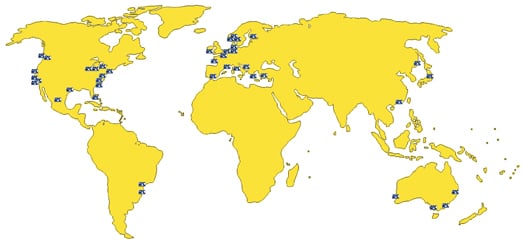
Locations of UK Halsey lofts around the world which are managed from Crosshaven by Des McWilliam
McWilliam Becomes President of World Sailmaking Firm
A prestigious appointment to the top of one of the world's biggest sail making firms is a life time reward for a member of a Cork sailing family who built a sail-making business in Ireland.
In a major Irish marine industry announcement, Crosshaven based sail maker Des McWilliam (62) has been appointed President of world sail making Group UK-Halsey.
UK-Halsey is one of the top three sailmakers in the world with 46 lofts worldwide and an annual estimated turnover of €15million.
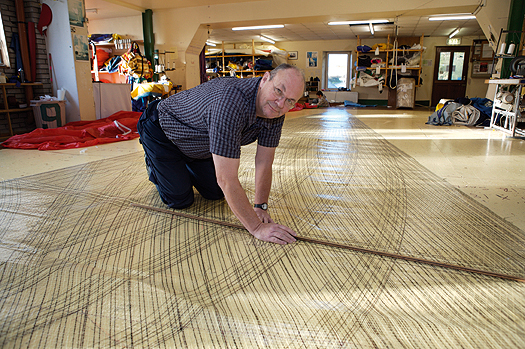
The loft is credited with using the most advanced technologies in the production of sails including Titanium sails where sail panels are glued rather than stitched for lightness and better shape.
McWilliam's appointment was made at the group's annual meeting in New York this week following the retirement of American founder Butch Ullmer.
Established in 1946 as Ulmer Sails, UK-Halsey Sailmakers is one of the oldest group of sail lofts in North America and has expanded around the
world to become the largest network of owner-run sail lofts.
There are 17 UK-Halsey lofts in North America, 21 in Europe, 3 in Australia, 3 in Asia and two in South America.
The UK Halsey loft in Crosshaven Co.Cork becomes the centre of operations as McWilliam rolls out new group strategies in challenging and competitive
times for the 45 sail makers.
Now in its fortieth year of sail manufacture in Ireland McWilliam says this week's appointment will underpin the future of the Cork loft in a time of
recession.
McWilliam employs six staff in Crosshaven, boosted this season by the appointment of Irish Fireball dinghy champion Kenneth Rumball.
Reviewing The Top OK Dinghy Gear
News that the OK Sailing Dinghy is knocking on the door in Ireland means it might be a good time to take a look at the gear used by the top 10 sailors at the recent OK Dinghy World Championships in Largs, Scotland. It would be easy to assume that New Zealand has somewhat of a monopoly on fast OK Dinghies. Five of the hulls, six of the sails and all 10 of the masts were of New Zealand origin in some shape or form. Robert Deaves reports.
The event this year was mainly held in light and shifty winds, so for some sailors the value this of data is perhaps reduced, however it is true to say that the top sailors rose to the top as they normally do. There were no real surprises.
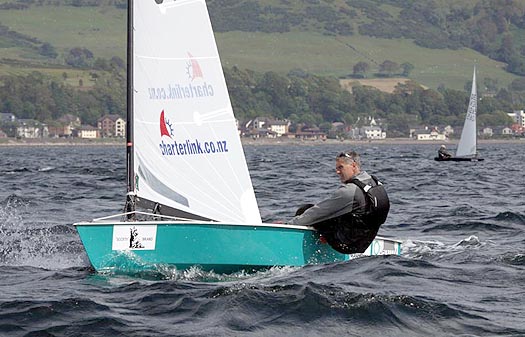
Alistair Deaves racing in Largs
To underline the competitiveness of this year's championship it is worth looking at the credentials of the top 10. Four were former World Champions, four were former Interdominion Champions, three were former Nordic Champions and eight were former National Champions. It was a top class field.
Hulls
The New Zealand made OK Dinghies from Icebreaker Boats NZ seem to be the boat of choice at the moment as many of the top sailors have chosen this builder. They have also won almost every major event of the past three years.
The Icebreaker shape goes back to the late 1960s when it was one of several designs from Alf Lock of Auckland. The fastest of his boats was used to take a mould and the Icebreaker came into existence. The boat has generally flat sections aft with minimal rocker and a fine entry to the bow. Upwind it tracks well and doesn't 'float' around as some of the fuller boats do. Offwind, while a fuller bowed boat would get into the plane slightly earlier, once the Icebreaker does, it has a faster top speed. In the light it is easy to handle and not as 'sticky' as some other designs.
Before 2008, Icebreaker hulls were really hard to get hold of outside New Zealand. The Kiwis didn't want the rest of the world to buy into their fast boats, and even though the mould passed through a number of hands, there was never much interest in exporting. But all that changed when Alistair Deaves took over the well used mould, refurbished it and to started to market the boat worldwide, no doubt helped by Karl Purdie (NZL) winning the 2008 World Championships in one of the first production boats.
However, according to Deaves, this is not the whole story. "The way the boat is constructed also plays a large part and Icebreaker Boats NZ has used modern computer design methods and materials to provide, what we think, is the best OK in the world. As much work as necessary is outsourced to ensure we get the best of everything."
"But of course the real reason why Icebreaker Boats NZ has such a good record is that we managed to sell to some of the best sailors, and perhaps that's the best endorsement of all. This is achieved by a policy of good quality and exceptional service, and customers often come back for new boats."
The moulding work for New Zealand Icebreakers is carried out in Auckland by Chris Brown of Performance Composites with the boats finished and marketed by Deaves through Icebreaker Boats NZ.
If it wasn't for the decline of the world economy, he says many more OK sailors would have chosen New Zealand made Icebreakers. "The import price was hiked out of reach for all but the rich and dedicated. In addition, some sailors pushed for copies of the Icebreaker to be made in Europe which has now led to three builders producing similar, but relatively cheaper copies."
Despite the crippling exchange rates some European buyers are still importing Icebreakers from New Zealand, though Deaves does admit that he has lost a lot of potential orders because of the complete nose dive in currency.
This season, like last season, Kiwi built Icebreakers have won most of the major events including the Interdominions, Spring Cup, Kiel Week, Warnemunde Week as well as many Nationals across Europe. It has also won five of the last seven world championships and last year's Europeans.
Ironically, though different NZ Icebreaker hulls won each and every race of this year's world championship, the highest place it achieved in the final overall standings was third. The championship was actually won by an Icebreaker copy, or Scolesbreaker, as it has been called, taken from Nick Craig's three times world championship winning New Zealand Icebreaker (though from a previous builder before Brown/Deaves) and built by Alex Scoles of UK based Idol Composites.
Though Craig sailed the most consistent series, by his own admission, he was not the fastest in the conditions at Largs. But, he said, "I am very pleased with my Scoles boat. Alex put in a lot of time ensuring the mould was perfectly fair, which has paid dividends with a fast and well-constructed boat that has a very long competitive life. It's nice to be able to focus on improving my rig whilst being 100% confident that my boat is fast."
Scoles commented, "It has been great for Idol Composites to have a world championship winning product and now my order book is bulging. The exchange rate has made Icebreaker Boats more expensive, but I don't think this had any significant impact on my orders so far."
In the last couple of years Idol Composites has sold OKs to the UK, Germany, Belgium, Ireland, Canada and Norway. This year it has had to take on extra staff and is looking to build more than 20 boats over the next 12 months. These are mainly for UK and Danish customers, though he also has potential orders from Sweden and Poland. Scoles also hopes to be able to ship a container full to Australia over the winter.
Idol composites offers what is considered the stiffest OK Dinghy available anywhere in the world. Everything is done in-house including the laminating, the painting and building the foils to maintain the high standards of build quality. As well as the standard gel coat finish, Idol Composites also offer 2-pack painted boats, which most of Scoles' customers opt for because of the saving in weight.
Scoles summed up his success, "It's a quality product together with a world title in a hull shape that OK sailors want." And that perhaps is the key. The Icebreaker shape is a shape from the past that everyone wants in the present.
However, all the other hulls in the top 10 are also old designs. The Hein is a German hull, with a fuller bow, the Rushworth is a copy of UK built Don O'Donnell hull from the 1970s and the Delfs copy is, as it suggests, a copy of the Swedish Delfs hull but built in Australia, with a full bow and very flat rocker that was very popular through the 1980s.
As ever there is nothing very new in the design of OK Dinghy hull shapes. As long as it is stiff, fair and down to weight, an old hull can be just as competitive as a new hull.
Masts
On an OK Dinghy, the mast is often considered the most important piece of kit. It is far more important that the hull or the sail, though of course the sail has to work with the mast to be any use. The move to carbon masts in 2004 sparked a lot of development worldwide, but in recent years the C-Tech mast from New Zealand has emerged as the most popular choice, principally after a lot of work from double world champion Karl Purdie (NZL). Even Craig has switched to a C-Tech after winning his first three titles with a Dutch built Celidh mast.
Out of any piece of kit on an OK Dinghy, C-Tech probably has the biggest market share. However, again, cost has become an issue as the exchange rate fell, opening up new development projects in Europe. But there is still some way to go on these.
Other masts in Largs included the UK built Aardvark and the Celidh.
Sails
Six out of the seven race wins in Largs were taken by sails built by Kiwis. Five of these were from Quantum Sails Potsdam, in Germany. The loft is run by Greg Wilcox, a former OK Dinghy world champion from New Zealand.
Wilcox, who himself finished fourth in Largs, explained, "Quantum Sails are individually made and matched to the sailor's weight, fitness level and, of course, mast bend. A lot of the other sails on the market are pre-made and the luff curve added last. This means there is really only one sail whereas we have a few different designs for different sailors."
"Our sails seem to have a bit of an edge when the conditions are quite varied. They seem to be very quick all round and especially downwind. I have worked with the top guys in the class like Karl Purdie and Thomas Hansson-Mild to develop the designs. They are both quite analytical and experienced and have provided very good feedback. I think this is obvious when they have won three of the last four worlds between them using these sails."
"Cloth choice is also very important however most sailmakers use Contender sailcloth which is very stable, light and reasonably durable. We try to get consistent cloth and work with our supplier towards this."
Craig used a UK built Speed sail, developed in conjunction with 2004 OK Dinghy World Champion Jim Hunt, but was never that happy with its light wind performance. Danish Green sails are very popular in Germany and Denmark and have been a key sailmaker for the class for decades. It's a similar story for Gale & Rimmington for Australia, though they tend to perform best in the windier conditions, something not experienced in Largs this year.
Other sails used in Largs include Pinnell & Bax from the UK, North from New Zealand, WB from Finland, Cicada from Germany and Linton from New Zealand.
Summary
Overall, whether by design or by choice, Kiwi knowledge and experience has produced some of the fastest combinations in the OK Dinghy in recent years and this trend looks set to continue. The main restriction for Europeans, and Americans, is the exchange rate, and before that returns to normality, if it ever does, the rest of the OK world needs to play catch up, or as in some cases, follow the same successful formula.
Table: Top 10 Gear at 2011 OK Dinghy World Championships
Shape Builder Sail Mast Board/rudder
1 Icebreaker copy Scoles Speed C-Tech Scoles
2 Hein. Hein Green C-Tech Hein
3 Icebreaker Icebreaker NZ Quantum C-Tech Jason King/KL
4 Icebreaker Icebreaker NZ Quantum C-Tech Deaves/C-Tech
5 Icebreaker Icebreaker NZ Linton/Quantum C-Tech Bumblebee
6 Rushworth Rushworth Quantum C-Tech Rushworth
7 Icebreaker Icebreaker NZ Green C-Tech Deaves
8 Icebreaker Icebreaker NZ Quantum C-Tech Deaves/C-Tech
9 Hein Hein Quantum C-Tech Hein
10 Jason King Delfs copy Gale & Rimmington C-Tech Jason King
Sail Training Vessel Rescued by Weymouth RNLI (Video here.)
The crew of the Weymouth RNLI relief Severn class all-weather lifeboat Beth Sell assisted a 24 metre sail training vessel with 16 persons onboard that was dismasted South of Portland Bill. The footage taken by crew members iphones and pentax hand held camera. SCROLL DOWN FOR VIDEO
Storms continued to batter Britain and Ireland's coast today as autumn arrived with a roar as forecasters warned the unsettled conditions could last for two weeks.
The Sail Training Vessel's wooden 90ft tall mast broke in half in the force seven winds and the boom, sail and rigging plunged into the choppy 12ft seas.The crew of the stricken yacht, who were all young adults, were unable to retrieve the stricken mast in the poor conditions and called the Coastguard for help.
The Weymouth RNLI lifeboat rushed to the scene at around 5.35pm yesterday.
None of the sailors were injured in the incident, although some were suffering from seasickness in the rough conditions.
The Daily Mail has more here

































